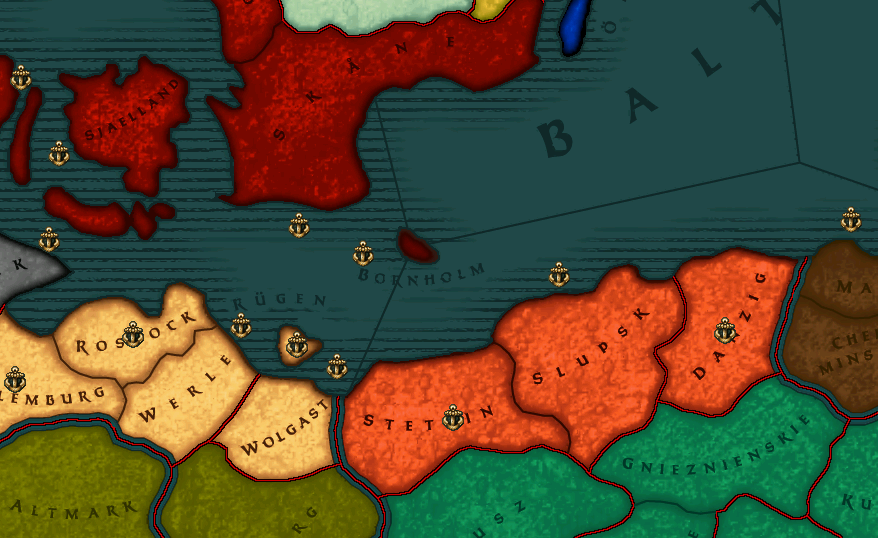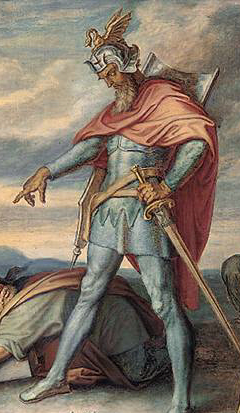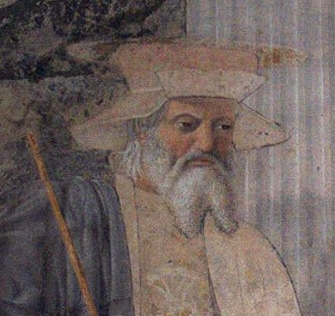Fascinating AAR with quality writing. It's also MMP. Which means I'll be definitely following it 
Kingdom, Power, Glory: Burgundy (Magna Mundi Platinum)
- Thread starter clblabin
- Start date
-
We have updated our Community Code of Conduct. Please read through the new rules for the forum that are an integral part of Paradox Interactive’s User Agreement.
You are using an out of date browser. It may not display this or other websites correctly.
You should upgrade or use an alternative browser.
You should upgrade or use an alternative browser.
Hehe Vanderanus. *grins*
In any case, very nice writing, both in style and as a whole on an interesting nation. Let's see where this goes.
In any case, very nice writing, both in style and as a whole on an interesting nation. Let's see where this goes.
Superbly written!
Just hope the Magna Mundi's shortcommings do not hinder your ability to write and tell the story.
As always, any doubt anyone has concerning the mechanics, just ask.
Just hope the Magna Mundi's shortcommings do not hinder your ability to write and tell the story.
As always, any doubt anyone has concerning the mechanics, just ask.
One advantage of MM's 1453 start: Burgundy gets to be more than a speedbump in the path of France. 
Excellent start!
Excellent start!
From the Baltic to the Rhone: The Burgundians
All tales must have a beginning, and here fiction has the advantage over fact, for the honest historian must always admit that the genesis of his tale is lost in time. What remains is only vague, half-remembered legend, supported by circumstantial evidence if any. And yet if legend is all we have, we must make the best of it.

The island of Bornholm, ancestral homeland of the Burgundians.
Our own story's legend begins on a small island in the Baltic Sea, about seventeen hundred years ago. The island was known in ancient Norse as Borgundarholm, or High-Mountain; today it is better known as Bornholm. Approximately three hundred years after the birth of Christ, the population of the island apparently vanished – at any rate, all signs of construction ceased, seemingly overnight.
A fair assessment of the historical record forces us to proceed with caution, but it might at least be speculated that the indigenous inhabitants, like so many of their brethren to the south in those times, did not die out, but took up a nomadic lifestyle for a time. They wandered south and east until they came into contact with the Western Empire, then entering the terminal stages of its life, yet for the moment under the vigorous if cruel hand of Valentinian I. And we may further speculate that it was this tribe whom the Romans named the Burgundii. Ammianus Marcellinus introduces them into written history with the assertion that they were bellicosos ("warlike") and metuendos finitimis universis ("terrorizing to all of their neighbors"). Valentinian made use of them to fight the Alemanii, but the deal turned sour.
Like so many other "barbarian" tribes, the Burgundians adopted Christianity, first in its Arian, then later its orthodox form. They moved westward, alternately fighting against and alongside the Empire, until they finally settled in (or, as the Romans insisted, were "granted" land in) the region that now bears their name, along with areas to the east, such as Worms, which seems to have been the Burgundian capital. The power of the Burgundians during this time period is exemplified by the reign of Gunther, who, along with Goar, King of the Alans, installed a Gallo-Roman senator, Jovinus, as a puppet emperor in 411. Jovinus did not last long, however – he was overthrown by an army loyal to Honorius and executed at Narbonne.

A coin issued during the brief reign of the usurper Jovinus, a puppet of the Burgundians.
Burgundian raids remained problematic enough for the Romans that the greatest general of the age, Flavius Aëtius, was sent in to destroy them in 436. He accomplished this task well, with the help of Hunnish mercenaries, and the earliest Burgundian kingdom was eradicated. The Romans moved the survivors southwards, to what is now southeastern France (formerly the Duchy of Savoy).

Gunther, Gundahar, or Gunnar, King of the Burgundians, killed in battle with the Romans in 436. In the nineteenth and twentieth centuries, he became a symbol of Burgundian Nationalism, particularly among the far right.
Not long afterward, however, in an ironic reversal, the Burgundians were again granted the status of Roman allies and took part in Aëtius's greatest victory, the Battle of the Catalaunian Plains, in which Attila's advance into Europe was halted and reversed.
The Burgundians were once again a major force the region, for a time even regaining sway over the emperors. The great Burgundian ruler of this period is doubtless Gundobad. In 473, King Gundioc died, and the kingdom was divided up among his four sons, including Gundobad. Perhaps inevitably, a struggle ensued, and Gundobad emerged the victor, having reunited the whole kingdom under his own rule. His long reign lasted until 516. In the two decades following his death, Burgundy's fortunes declined quickly.
Gundobad's successor was St. Sigismund, who died in 524 defending Burgundy from a Frankish invasion. Sigismund's brother, Godomar, became the last of the Burgundian kings. He perished in 534 at the hands of the Franks, and Burgundy became Merovingian territory.

St. Sigismund of Burgundy, (r. 516-524), penultimate King of the Burgundians. Not surprisingly, during the age of Romantic Nationalism, he was strongly identified as a "forerunner" of St. Philip the Pious.
At this point, we may fairly say that the history of the Burgundians is over. They largely assimilated into Frankish culture, and the only major lasting contribution they made is their name.
In the post-Revolutionary era, however, the myths and legends of the Burgundians became more important than the historical facts. Of all the major states, Burgundy was the most ethnically diverse – something which had occasionally been pointed out in the past as a strength, but which was now seen as a dangerous weakness in an era of rising nationalism. When the early Dutch nationalist Constantijn Brandt declared in his famous treatise, "Burgundy is not a nation; Burgundy will never be a nation," he was merely stating what many Burgundians had come to unconsciously fear. The glorification of past rulers like Sigismund and Gunther and great events like the Battle of the Catalaunian Plains ("The first great rescue of Europe by Burgundy," according to one nineteenth-century Burgundian historian) was so intense precisely because of this growing insecurity. Although intense nationalism has largely died out since the end of the Cold War, it has left its mark in the form of many, many statues and monuments throughout Burgundian territory. This period has also imprinted itself onto the Burgundian imagination in other ways. For instance, in 1973, a series of festivals were held in West Burgundy to celebrate the 1500th anniversary of Gundobad's coronation. Much was made at the time of Gundobad's ultimate success in reunifying a divided Burgundy.
So much, then, for the history of the first Burgundians. Next we will briefly follow Burgundy's fortunes during the medieval period, as a land straddling the divide between France and the Holy Roman Empire.
Last edited:
Thanks once again for all the encouraging comments. These next entries might not be everybody's cup of tea, but I want to give at least a little taste of Burgundy's history before the game itself starts.
No, keep going. This is interesting stuff, and background is almost always useful to the reader. Plus, of course, all those little alternate history tidbits you've been throwing out--like mentioning the Cold War in this last update, and how Burgundy was divided during said war in an earlier update--really draw you in and makes you want to know what's going to happen.
Last edited:
exquisite! it's like reading a mystery story, you gave us some clues, protagonists and you're making us try to put the puzzles right
So the whole games been played already and your just writing it up. I could never do that.
It's my cup of tea and I want a whole kettle of it.
The "play first, then write" angle is a bit odd at first but it does provide for an amazing perspective.
The "play first, then write" angle is a bit odd at first but it does provide for an amazing perspective.
This is something to behold! I really love the depth and the building momeentum you are achieving. If you finish this before MMP2 is out we will be very grateful to include your AAR as an example of play and of inspiration in the manual.
Ubik, wow, thanks, that is an honor!
Cliffracer RIP -- Yeah, it took a lot of discipline, but I'm now definitely sure it was the right choice. A lot of this preliminary stuff was actually written back in January, well before I began to play the game, and now I'm just going back and inserting references to what happened later.
Thanks also to everyone else for your support. I'm glad this section is popular, because it looks like I'm going to have to add a fourth chapter . Next update coming in a few moments!
. Next update coming in a few moments!
Cliffracer RIP -- Yeah, it took a lot of discipline, but I'm now definitely sure it was the right choice. A lot of this preliminary stuff was actually written back in January, well before I began to play the game, and now I'm just going back and inserting references to what happened later.
Thanks also to everyone else for your support. I'm glad this section is popular, because it looks like I'm going to have to add a fourth chapter
Last edited:

